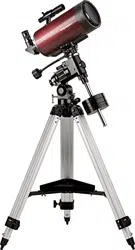Loading ...
Loading ...
Loading ...

the polar alignment. The telescope should be moved only
about its R.A. and Dec. axes.
The Polar Axis Finder Scope
A nice feature of the StarMax 127 EQ is the polar axis finder
scope housed inside the R.A. axis of the equatorial mount
(see Figure 4). When properly aligned and used, it makes
accurate polar alignment quick and easy to do. Alignment of
the polar finder need only be done once, unless it gets
bumped or otherwise shifts its position.
Remove the round cover cap from the front opening in the
R.A. axis of the mount (see Figure 6). Look through the polar
finder at a distant object during the day. Focus the polar finder
so that the images and reticle are sharp by rotating the eye-
piece end of the finder. Notice that the reticle pattern consists
of a crosshair with a circle around the middle. On the circum-
ference of this circle is a tiny circle; this is where Polaris will
be placed for accurate polar alignment once the finder is
properly aligned. Alignment of the polar finder is best done
during the day, before going out into the field at night.
Aligning the Polar Axis Finder Scope
Aligning the polar axis finder scope so that it will accurately
point at the true north pole is a two-step procedure. First, the
polar finder must be rotated in its housing so that the small
circle in which Polaris will be placed is in the proper initial
position.Next, the polar axis finder must be adjusted so that it
points directly along the mount’s R.A. axis.
We will start by aligning the polar finder rotationally. Refer to
Figure 4.
1. Loosen the large thumbscrew just above the R.A. setting
circle.Rotate the R.A.setting circle until the line above the “0”
on the setting circle lines up with the pointed indicator that is
cast into the mount (located directly below the large thumb-
screw;see Figure 4). Retighten the thumbscrew.
2.Rotate the date circle until the “0” line on the meridian off-
set scale lines up with the time meridian indicator mark.The
meridian offset scale is printed on the inner circumference of
the date circle, and is labeled “E20” to “W20”.The time merid-
ian indicator mark is an engraved line on the exterior of the
polar finder’s housing. It is on the “ring” of the housing that is
closest to the date circle.
3.The R.A. setting circle is labeled in hours, from “0” to “23”
(military time). For Northern Hemisphere observers, refer to
the top numbers on the setting circle. Each small line repre-
sents 10 minutes of R.A.The date circle is labeled from “1” to
“12”, with each number representing a month of the year (“1”
is January, “2” is February, etc.). Each small line represents a
two-day increment.
4.Loosen the R.A. lock lever and rotate the mount about the
R.A. axis until the March 1 indicating mark (the long line
between the “2” and the “3”) on the date circle lines up with
the 4 PM mark (the long line above the “16”) on the R.A. set-
ting circle. You may find it convenient to remove both the
counterweights and the telescope optical tube to do this.
5.Now, loosen the three thumbscrews on the polar finder
housing and rotate the polar finder so the small circle where
Polaris will be centered is located straight down from the
intersection of the crosshairs.Retighten the thumbscrews.
The polar axis finder scope is now properly set in its initial
position. Next, we must align it so that it is exactly parallel to
the mount’s R.A. axis:
6.Look through the polar finder at a distant object (during the
day) and center it on the crosshairs.You may need to adjust
the latitude adjustment T-bolts and the tripod position to do
this.
7.Rotate the mount 180° about the R.A. axis.Again, it may be
convenient to remove the counterweights and optical tube
first.
8.Look through the polar finder again. Is the object being
viewed still centered on the crosshairs? If it is, then no further
adjustment is necessary. If not, then look through the polar
finder while rotating the mount about the R.A. axis.You will
notice that the object you have previously centered moves in
a circular path. Use the three thumbscrews on the housing to
redirect the crosshairs of the polar finder to the apparent cen-
ter of this circular path. Repeat this procedure until the
position that the crosshairs point to does not rotate off-center
when the mount is rotated in R.A. Once this is accomplished,
retighten the thumbscrews.
The polar axis finder scope is now ready to be used. When
not in use, replace the plastic protective cover to prevent the
polar finder from getting bumped, which could knock it out of
alignment.
Using the Polar Axis Finder
When using the polar finder in the field at night, you will need
a red flashlight to illuminate the finder’s reticle. Shine the
flashlight at an angle into the front opening in the R.A. axis.
Do not shine it directly into the opening, or the light will be too
bright, and you will also obstruct the view of the polar finder.It
Figure 8. For polar alignment, position the tripod so that the “N”
label at the base of the mount faces north.The two azimuth fine
adjustment knobs above it are used to make small adjustments to
the mount’s azimuth position.
8
Azimuth
fine adjustment
knobs
Tripod
attachment
knob
Loading ...
Loading ...
Loading ...
